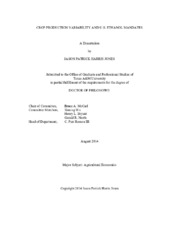| dc.description.abstract | U.S. agricultural commodity prices have been volatile in recent years, attributed to many factors, including renewable fuel standard mandates (RFS). While the RFS is legislatively able to be altered, the mandate largely required the same volume of corn for ethanol in the 2012 drought year as it would have if 2012 were a normal production year. This caused corn prices to surge, bestowing significant economic ramifications throughout the agricultural industry. An important question arose from these events, was this avoidable with a RFS relaxation policy? In this work, the economic effects of such a policy that relaxes the conventional ethanol mandates in cases of major corn production shortfalls are investigated to determine the market relationships between RFS policy and commodity markets. This is done in a three step process. First the historical incidence of shortfalls is addressed by developing a stationary probability distribution of total and regional production using econometric procedures. Second, the short-run economic impact of RFS relaxation alternatives is investigated using an optimization modeling framework where crop mix and livestock breeding herds are held fixed. Third, the long-run implications of RFS relaxation are investigated by coupling the previous model with a stochastic optimization framework of ag-producer decisions with recourse. When a shortfall driven relaxation policy is in place, crop mix/livestock breeding decisions are able to adjust.
The results show RFS relaxation has a significant impact on reducing price spikes and livestock production decreases due to reduced feeding costs when shortfalls occur. Although an ethanol waiver benefits consumers through decreased commodity prices, the reduction in producer welfare was found to be greater, resulting in an overall negative welfare impact when only considering agricultural impacts.
In the longer-run analysis, the RFS relaxation again mitigates price spikes during production shortfall years but also stimulates a producer response of decreasing corn acreage. This caused corn prices in non-shortfall years to increase, resulting in a negligible impact on average long-run corn prices, while reducing commodity price variability. The model findings demonstrated that positive risk reduction implications could exist from a production-dependent conventional ethanol waiver, with limited long-run changes to future expected prices. | en |


